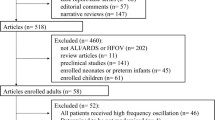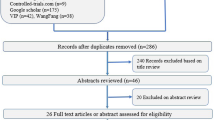Abstract
Among unconventional modalities of respiratory support, high-frequency oscillatory ventilation (HFOV) is surely the most commonly used in neonatal and pediatric critical care. Despite it being widely used in the pediatric world, such use is not mirrored in adult critical care and some hospitals and clinics do not use HFOV even for the youngest of patients. This apparent discrepancy is partially due to the lack of strong evidence supporting the benefits of using HFOV in various clinical settings, while gathering significant levels of evidence about some of the associated issues has also proved difficult.
Access this chapter
Tax calculation will be finalised at checkout
Purchases are for personal use only
Similar content being viewed by others
References
Jane Pillow (2005) High frequency oscillatory ventilation: Mechanisms of gas exchange and lung mechanics. Crit Care Med 33(3 suppl): S135-S141
McCulloch PR, Forkert PG, Froese AB (1988) Lung volume maintenance prevents lung injury during high frequency oscillatory ventilation in surfactant-deficient rabbits. Am Rev Respir Dis 137(5):1185–1192
Boynton BR, Hammond MD, Freberg JJ et al. (1989) Gas exchange in healthy rabbits during high-frequency oscillatory ventilation. J Appl Physiol 66:1343–1351
Kamitsuka MD, Boynton BR, Villanueva D et al. (1990) Frequency, tidal volume and mean airway pressure combinations that provide adequate gas exchange and low alveolar pressure during high frequency oscillatory ventilation in rabbits. Pediatr Res 27:64
von der Hardt K, Kandler MA, Fink L et al. (2004) High frequency oscillatory ventilation suppresses inflammatory response in lung tissue and microdissected alveolar macrophages in surfactant depleted piglets. Pediatr Res. Feb 55(2):339–46. Epub 2003 Dec 8
Delemos RA, Coalson JJ, Gerstmann DR et al. (1987) Ventilatory management of infant baboons with hyaline membrane disease: the use of high frequency ventilation. Pediatr Res 21:594-602
Ventre KM, Arnold JH (2004) High frequency oscillatory ventilation in acute respiratory failure. Paediatr Respir Rev 5:323–332
van Genderingen HR, Versprille A, Leenhoven T et al. (2001) Reduction of oscillatory pressure along the endotracheal tube is indicative for maximal respiratory compliance during high-frequency oscillatory ventilation: a mathematical model study. Pediatr Pulmonol Jun 31(6):458–463
Arnold JH, Anas NG, Luckett P et al. ( 2000) High frequency oscillatory ventilation in pediatric respiratory failure: a multicenter experience. Crit Care Med 28:3912–3919
Arnold JH, Hanson JH, Toro-Figuero LO et al. (1994) Prospective, randomised comparison of high-frequency oscillatory ventilation and conventional mechanical ventilation in pedi- atric respiratory failure. Crit Care Med 22:1530–1539
Froese AB, Kinsella JP (2005) High-frequency oscillatory ventilation: Lessons from the neonatal/pediatric experience. Crit Care Med 33:S115-S121
Marlow N, Greenough A, Peacock JL et al. (2006) Randomised trial of high frequency oscillatory ventilation or conventional ventilation in babies of gestational age 28 weeks or less: respiratory and neurological outcomes at 2 years. Arch Dis Child Fetal Neonatal Ed 91:F320- F326
Soll RF ( 2006) The clinical impact of high frequency ventilation: review of the Cochrane meta-analyses. J Perinatol 26(Suppl 1):S38-S42
Henderson-Smart DJ, De Paoli AG, Clark RH et al. (2009) High frequency oscillatory ventilation versus conventional ventilation for infants with severe pulmonary dysfunction born at or near term. Cochrane Database of Systematic Reviews, Issue 3. Art. No.: CD002974
Cools F, Askie LM, Off Ringa M, on behalf of the PreVILIG collaboration (2010) Elective high-frequency oscillatory versus conventional ventilation in preterm infants: a systematic review and meta-analysis of individual patients’ data Lancet 375:2082–2091
Migliazza L, Bellan C, Alberti D et al. (2007) Retrospective study of 111 cases of congenital diaphragmatic hernia treated with early high-frequency oscillatory ventilation and presur- gical stabilization. J Ped Surg 42:1526–1532
Meliones JN, Bove EL, Dekeon MK et al. (1991) High-frequency jet ventilation improves cardiac function after the Fontan procedure. Circulation 84:III,364-368
Bojan et al. ( 2011) High-frequency oscillatory ventilation and short-term outcome in neonates and infants undergoing cardiac surgery: a propensity score analysis. Critical Care 15:R259
Cartotto R, Ellis S, Gomez M et al. (2004) High frequency oscillatory ventilation in burn patients with the acute respiratory distress syndrome. Burns 30(5):453–463
Cartotto R, Ellis S, Smith T (2005) Use of high-frequency oscillatory ventilation in burn patients. Crit Care Med Mar 33(3 Suppl):S175-S181
Walia G, Jada G, Cartotto R (2011) Anesthesia and intraoperative high-frequency oscillatory ventilation during burn surgery. J Burn Care Res 32(1):118–123
Cioffi WG, de Lemos RA, Coalson JJ et al. (1993) Decreased pulmonary damage in primates with inhalation injury treated with high-frequency ventilation. Ann Surg. Sep 218(3):328–35; discussion 335–337
Lo TY, Jones PA, Freeman JA et al. (2008) The role of high frequency oscillatory ventilation in the management of children with severe traumatic brain injury and concomitant lung pathology. Pediatr Crit Care Med Sep 9(5):e38-e42
Finkielman JD, Gajic O, Farmer JC et al. (2006) The initial Mayo Clinic experience using high-frequency oscillatory ventilation for adult patients: a retrospective study. BMC Emerg Med 6:2
Mehta S, Granton J, MacDonald RJ et al. (2004) High-frequency oscillatory ventilation in adults: the Toronto experience. Chest 126:518–527
Wunsch H, Mapstone J, Takala J (2005) High-frequency ventilation versus conventional ventilation for the treatment of acute lung injury and acute respiratory distress syndrome: a systematic review and cochrane analyses. Anesth Analg Jun 100(6):1765–1772
De Luca D, Piastra M, Conti G (2011) Kinetics of oxygenation improvement and the timing of HFOV institution. Pediatr Pulmonol Dec 46(12):1251–1252
Fedora M, Klimovic M, Seda M et al. (2000) Effect of early intervention of high-frequency oscillatory ventilation on the outcome in pediatric acute respiratory distress syndrome. Bratisl Lek Listy 101(1):8–13
Kohelet C, Perlman M, Kirpalani H et al. (1998) High-frequency oscillation in the rescue of infants with persistent pulmonary hypertension. Crit Care Med 16:510–516
Berner ME, Hanquinet S, Rimensberger PC (2008) High frequency oscillatory ventilation for respiratory failure due to RSV bronchiolitis. Intensive Care Med 34(9):1698–702. Epub 2008 May 24
Ben Jaballah N, Khaldi A, Mnif K et al. (2006) High-frequency oscillatory ventilation in pe- diatric patients with acute respiratory failure. Pediatr Crit Care Med 7:362–367
Clark RH, Yoder BA, Sell MS (1994) Prospective, randomized comparison of high-frequency oscillation and conventional ventilation in candidates for extracorporeal membrane oxygenation. J Pediatr 124:447–454
Ten IS, Anderson MR ( 2006) Is high-frequency ventilation more beneficial than low-tidal volume conventional ventilation? Respir Care Clin N Am 12(3):437–451
Rotta AT, Steinhorn DM ( 2006) Is permissive hypercapnia a beneficial strategy for pedi- atric acute lung injury? Respir Care Clin N Am 12(3):371–387
Kneyber MC ( 2011) High-frequency oscillatory ventilation and pediatric cardiac surgery: Yes, we can! Crit Care 15(6):1011. Epub 2011 Nov 24
Slee-Wijffels FYAM, van der Vaart KRM, Twisk JWR et al. (2005) High Frequency Oscillatory Ventilation in Children: a single center experience of 53 cases. Crit Care 9:R274-R279
Randolph AG ( 2009) Management of acute lung injury and acute respiratory distress syndrome in children. Crit Care Med 37:2448–2454
Diaz JV Brower R, Calfee CS, Matthay MA ( 2010) Therapeutic strategies for severe acute lung injury. Crit Care Med 38:1644–1650
Henry E, Fessler MD, Derdak S et al. ( 2007) A protocol for high-frequency oscillatory ventilation in adults: Results from a roundtable discussion Crit Care Med Vol 35, No 7
Author information
Authors and Affiliations
Corresponding author
Editor information
Editors and Affiliations
Rights and permissions
Copyright information
© 2013 Springer-Verlag Italia
About this chapter
Cite this chapter
De Luca, D., Visconti, F., Piastra, M., Conti, G. (2013). High-Frequency Oscillatory Ventilation in Intensive Care Units: Children and Neonates. In: Astuto, M. (eds) Pediatric Anesthesia, Intensive Care and Pain: Standardization in Clinical Practice. Anesthesia, Intensive Care and Pain in Neonates and Children. Springer, Milano. https://doi.org/10.1007/978-88-470-2685-8_3
Download citation
DOI: https://doi.org/10.1007/978-88-470-2685-8_3
Publisher Name: Springer, Milano
Print ISBN: 978-88-470-2684-1
Online ISBN: 978-88-470-2685-8
eBook Packages: MedicineMedicine (R0)




